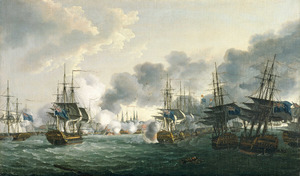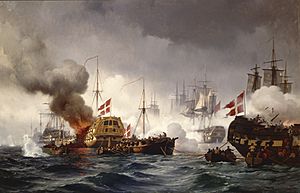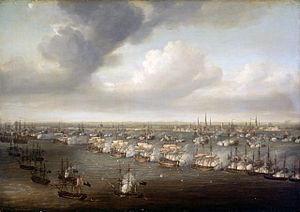English Wars (Scandinavia) facts for kids
Quick facts for kids English Wars |
|||||||||
|---|---|---|---|---|---|---|---|---|---|
| Part of the French Revolutionary Wars and the Napoleonic Wars | |||||||||
 Battle of Copenhagen, by John Thomas Serres |
|||||||||
|
|||||||||
| Belligerents | |||||||||
|
Supported by: |
Supported by:
|
||||||||
| Commanders and leaders | |||||||||
|
|||||||||
|
|||||||||
The English Wars were a series of fights between the United Kingdom (often called England back then) and Sweden against Denmark-Norway. These wars were part of the bigger Napoleonic Wars that swept across Europe. The United Kingdom declared war on Denmark-Norway because they disagreed about Denmark's neutral trading. Britain also wanted to stop the Danish navy from falling into the hands of France. The wars started with the first Battle of Copenhagen in 1801. Later stages from 1807 included the Gunboat War, the Dano-Swedish War of 1808–09, and the Swedish invasion of Holstein in 1814.
Contents
Why the Wars Started: The Prelude
After Denmark-Norway's foreign minister died in 1800, Crown Prince Frederick took more control. He allowed Danish merchant ships to travel with naval protection. This was called 'armed neutrality'. Denmark insisted that ships sailing under its flag were safe from inspection. This policy was risky because many non-Danish ships used the Danish flag to avoid trouble. While profitable, it also made the United Kingdom unhappy.
In 1799, a British sailor was killed trying to check a Danish ship. Then, in 1800, Russia started a new group called the Second League of Armed Neutrality. This group aimed to protect neutral trade from Britain. Britain reacted strongly. A British fleet tried to inspect a Danish convoy near Ostend. The Danish captain refused and fought back but was defeated.
Denmark-Norway then officially joined the League of Armed Neutrality in December 1800. This group included Sweden, Russia, and Prussia. However, in 1801, Russia allied with France. Russia and France then blocked all European ports to British trade. This made the United Kingdom demand that Denmark-Norway leave the League.
Denmark-Norway faced a tough choice. If they left the League, they would seem to side with Britain. This would likely lead to an invasion by France or Russia's allies. Sweden wanted to take Norway from Denmark. Prussia might try to conquer Jutland. Denmark-Norway believed they could fight a naval war with Britain better than a land war with Prussia, Russia, and Sweden. So, they refused Britain's offers to talk. The United Kingdom then sent a fleet to Denmark in March 1801 to force them out of the League.
The Course of the Wars
The First Battle of Copenhagen (1801)
The Danes started getting ready for a British attack. But many of their ships were not ready after winter. It would take weeks to prepare them. So, Denmark planned to protect Copenhagen by anchoring ships in a curved line. This line stretched from Trekroner Fort to Amager. Olfert Fischer led the defense from his ship, the Dannebrog. They even offered money to get more crew members, who received quick training.
The British fleet sailed past Kronborg easily on March 30. They continued towards Copenhagen. Crown Prince Frederick had refused help from Sweden. He feared Sweden would get special trading rights. The Swedish fleet was on its way to help, but bad weather slowed them down. By midday, the British fleet anchored near Taarbæk reef.
Admiral Sir Hyde Parker planned to attack the Danish fleet from the south. The rest of his ships would fight the Danish blockade. The attack would end with a strike on Trekroner island. The British prepared for days. They sailed further south, past Copenhagen, to avoid Danish land batteries.
Lord Horatio Nelson led twelve British ships. His job was to get them through Copenhagen's tricky defenses. Nelson decided to attack. Four of his biggest ships quickly got stuck. The battle was long and fierce. After four hours, no one was winning clearly. Admiral Parker, who was further back, signaled Nelson to pull back. But Nelson wanted to win and ignored the order.
Nelson noticed that many Danish ships that had surrendered were still firing. He sent a message to Crown Prince Frederick. Nelson argued that he couldn't guarantee the safety of Danish crews if they kept fighting after surrendering. Crown Prince Frederick saw that the battle was pointless. He agreed to a truce without asking his commanders.
After the First Battle
While the British fleet sailed to Denmark, the political situation changed. Britain had started peace talks with France. They also sent diplomats to Russia. What they didn't know was that the Russian Tsar was soon killed. His son, Alexander, took over. Tsar Alexander was more interested in being friends with Britain. Because of the Tsar's death, the League of Armed Neutrality broke up.
The Swedish King, Gustav IV Adolf, saw Denmark-Norway's truce as a betrayal. He tried to use Denmark's weak position to gain Norway. But other major European powers did not support this plan.
Prussia, which Denmark had helped join the League, also left the League. Prussia then demanded that Denmark give up Hamburg. Denmark-Norway had faced many difficult diplomatic defeats. They turned to Britain for direct talks. They wanted their captured ships back. They also wanted Britain to leave their occupied colonies. But these talks didn't go well. Denmark had nothing to offer or threaten Britain with.
A Time of Waiting: The Interval
After their defeat in 1801, Denmark-Norway had to change some of its neutral policies. But they could still trade with both Britain and France. This lasted until war broke out again between Britain and France in May 1803. This war led to more fighting between France and the Austrian Empire. After Napoleon's big victory in 1805, France controlled most of Central Europe.
In 1806, war also started between France and Prussia. French forces quickly moved towards Denmark's borders. Denmark had to react. Crown Prince Frederick placed most of his army in Holstein. This showed he didn't want to join the fighting in northern Germany. It also protected Denmark from a French invasion.
But it became harder for Denmark-Norway to stay neutral. Especially after Napoleon defeated Prussia in late 1806. On November 21, Napoleon announced the Continental System. This was a blockade to stop all European trade with Britain. In response, Britain banned neutral ships from trading with France and its allies.
In July 1807, Russia joined the Continental System. Russia and France agreed to force other neutral European countries to join the blockade. When Britain found out, they gave Denmark-Norway an ultimatum. Denmark had to either join Britain's side and give them their fleet, or hand over the fleet as a guarantee of neutrality. Britain feared Denmark would join France or that France would take the Danish fleet. Crown Prince Frederick found Britain's demands impossible. If Denmark allied with Britain, France would attack. And British and Swedish forces would not be able to help Denmark much.
The Second Battle of Copenhagen (1807)
Denmark-Norway refused Britain's ultimatum. So, Britain landed a large force in Zealand on August 16, 1807. This was done without a formal declaration of war. King Christian VII and Crown Prince Frederick were in Holstein with most of the Danish army. The new commander, Ernst Peymann, had to face the British with fewer, untrained soldiers.
The British quickly started to surround Copenhagen. Small fights happened south of the capital. On August 29, a large group of Danish soldiers were defeated near Køge by British forces. These forces were led by Sir Arthur Wellesley.
Danish attempts to defeat the British on land failed. The Danish fleet was not ready for battle. So, the Danes prepared for a British attack on the capital. But the attack never came. Instead, the British started to bombard the city. The bombing lasted from September 2 to 6. They even used new Congreve rockets. After the bombing on September 6, Peymann surrendered the city. He was sentenced to death for this but later pardoned.
The British took all the Danish ships they could sail back to England. They burned the rest. They also took everything valuable from the Danish naval base at Holmen. Britain offered Denmark-Norway an alliance after the attack. But Crown Prince Frederick refused. France had already given Denmark an ultimatum: join the Continental System or face war.
In December, the British Navy also took control of the Danish West Indies. They occupied these islands for almost eight years.
Denmark Allies with France
The British attack on Copenhagen made Denmark-Norway decide to join France. On October 31, the French-Danish alliance was signed. Denmark-Norway was now officially at war with Britain. This led to Britain occupying all Danish colonies. Britain also blocked shipping between Denmark and Norway. This caused shortages in Norway.
Sweden had been an ally of Britain against France since 1805. Russia, after making peace with France, allied with Napoleon. So, Tsar Alexander saw a chance to attack Sweden and take Finland. In February 1808, the Russians started the Finnish War. They marched 24,000 men into Finland.
Crown Prince Frederick of Denmark also saw a chance. He wanted to take back areas Denmark-Norway had lost to Sweden in earlier treaties. Denmark had promised France and Russia to help in an attack against Sweden. So, on March 14, 1808, Denmark-Norway declared war on Sweden. Napoleon sent extra troops from France, Spain, and the Netherlands to Denmark. These troops were led by French Marshal Jean-Baptiste Bernadotte. They were supposed to invade Sweden with Danish-Norwegian soldiers.

But Bernadotte's troops never got past Zealand. The ice in the straits melted early. The British fleet also appeared, making it hard to cross to Sweden. Bernadotte's troops stayed in Kolding, where they accidentally caused a fire at Koldinghus. With Bernadotte's troops stuck, the war shifted to the Norway-Sweden border. Swedish troops invaded Norway in mid-April. However, the invasion stopped. There were only small fights between Norwegian and Swedish forces. The Swedish troops retreated later that summer.
In August, news of the Madrid Uprising reached the Spanish troops in Denmark. This led to a rebellion among the Spanish soldiers. The British then helped most of these Spanish troops return to Spain. There, they fought against the French in the Peninsular War.
Financial Troubles: State Bankruptcy
From 1807 to 1813, the war caused very high inflation. Wages and grain prices went up a lot. It was expensive for Denmark to keep an army in Holstein. In 1810, the Danish government tried to collect more taxes. But they didn't have the right system to make it work. Instead, they printed more and more banknotes to cover their costs.
From 1806 to 1813, the total value of money in circulation increased six times. But the real value of the banknotes dropped a lot. The government itself went bankrupt. To fix this, they quickly changed the money system on January 5, 1813. A new bank was created to replace the old ones. It would mint new coins with values tied to foreign money. This made people with small savings, government bonds, or high-value banknotes much poorer.




